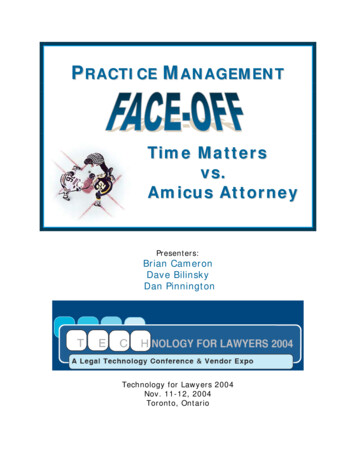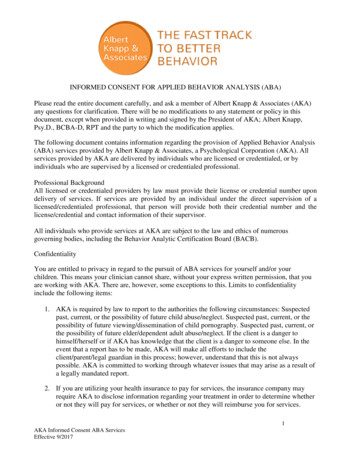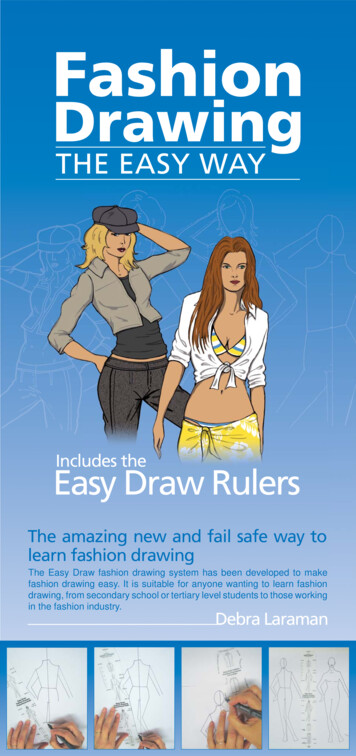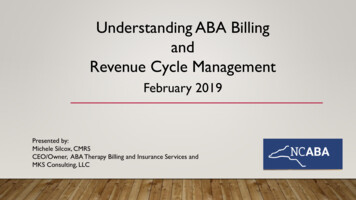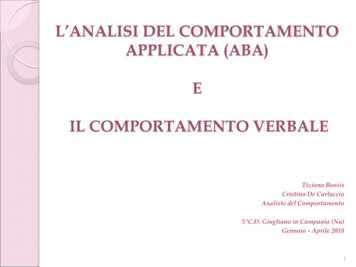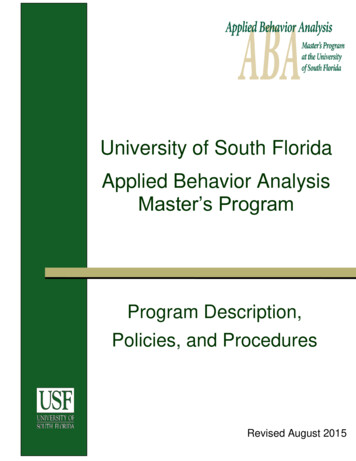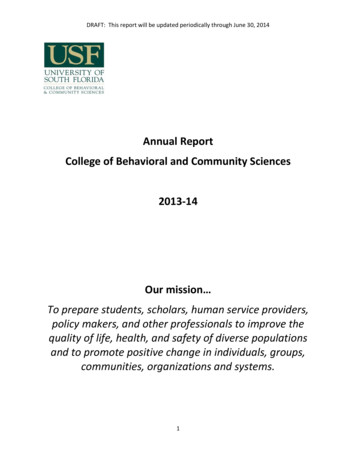
Transcription
WV Birth to Three Family Guide toApplied Behavior AnalysisWhat is ABA?Applied Behavior Analysis(ABA) is a science thatuses laws of learning tounderstand and teachbehavior. Strategiesbased on ABA take aplanned approach tochanging what comesbefore and after abehavior to teach newskills and decreasechallenging behaviors.Part of this planning isfinding items andactivities the child enjoysand using them asrewards.For example, a parentmay begin teachingimitation by showing thechild how to roll a toy car,helping the child roll thecar, and rewarding thechild with tickles. Aparent may use ABAstrategies to teachrequesting by providingjuice when the child asksappropriately instead ofwhen the child throws atantrum.General, AmericanAcademy of Pediatrics,Autism Speaks, and manymore organizations.What will my ChildLearn?Social skillsPlay skills“Your child will learnskills that meet his orher individual needs.”ABA strategies can beLanguage andcommunication skillsPre-academic skillsAttending skillsused with anyone of anyage and are not limited toImitation skillsteaching children withautism spectrum disordersIncreasing interests(ASD), although ABAstrategies are effectiveIncreasing engagementfor teaching children withImproving sleep andfeedingASD and have beenendorsed by the SurgeonDecreasing challengingbehaviorHow will ABA Support myChild and Family?The goal of using ABAin daily family routineschild’s learning growthstrategies is to improvewhere they use andand development and areyour child’s quality of lifemaster the skills needednatural teachers. ABAand teach new skills.to participate in familywill not only help yourResearch tells us thatand community life. Wechild learn but will alsoinfants and toddlers learnalso know that familiesteach you ways tobest through engagementare crucial in supporting asupport your child’s1development. It will give youthe skills you need topromote and reinforce yourchild’s use of new skills.WVBTT Family Guide to Applied Behavior Analy-
Where will ABA services be provided?What does an ABAProgram Look Like?Just as no two children are alike, notwo ABA programs will be the same.Your WV Birth to Three team will talkwith you to determine your goals foryour child and will conduct assessmentsto determine your child’s strengths,their needs, and how they learn best.Once you and your team haveestablished goals for your child, theteam will work with you to developstrategies to teach your child newskills and improve behavioral problems.For very young children with ASDmost strategies will beimplemented during normalroutines (e.g., bath time, mealtime, play time) that your familyengages in every day. ABAprograms can be implemented inall settings including your home,daycare, and community (e.g.,going to the grocery store, eatingout at a restaurant, getting ahaircut, etc.). As childrenapproach age 3 and get ready toenter more structured programslike preschool, the ABA programmay include some teachingsessions at a table, but should still“ABA programs can beimplemented in all settingsincluding your home, daycare,and community.”What do we mean by Evidence-BasedPractice?Every parent wants to find thebest way to help their child learnnew skills. As a parent, you haveprobably heard of many strategiesfor teaching new skills. Some ofthese teachingstrategies have lotsof research behindProfessionals Who Use Science.them but othersmay not. Some Teachersstrategies workfor some children Speech Therapistsand families, some Occupational Therapistsdo not. Thosestrategies Physical Therapistsconsistently Licensed Professional Counselorsdemonstrated by Clinical Psychologistsresearch to beeffective in Board Certified Behavior Analyststeachingindividualswith ASD are2include lots of time playing orengaging in family routines. Afterstrategies are developed, yourteam will collect data or otherinformation during visits todetermine how well your child islearning and if the strategies areworking. The team may ask you tocollect information too to helpdetermine how the program isworking throughout the week.called “evidence-based practices.”Using strategies that are based onscience first started in medicine.Physicians wanted to be sure theywere using the best medicine totreat particular diseases.The professionals on your teamshould use strategies that aresupported by science, and theyshould also make sure your child islearning new skills at home, indaycare, and/or in the community.Your team will help you collectinformation to determine if yourchild is learning or if you need totry something else. If you have aquestion about the science behinda particular strategy, you shouldfeel comfortable asking your teamfor more information.WVBTT Family Guide to Applied Behavior Analysis
What is a BCBA or BCaBA?A Board Certified Behavior Analyst (BCBA) is a professional who might be a part of your team. BCBAs have aMaster’s degree, met coursework requirements in behavior analysis, passed a test, and trained under a BCBA.BCBA’s work in a lot of different settings (homes, schools, community, hospitals, etc.) with a variety of differentpopulations, including children with ASD and other disabilities. In some cases, you may work with a BoardCertified Assistant Behavior Analyst (BCaBA). BCaBAs have a Bachelor’s degree, have taken other coursework inbehavior analysis, passed a test, and worked under a BCBA. BCaBAs can directly teach children skills and/or teachothers, such as families, to implement programs under the supervision of a BCBA.BCBAs and BCaBAs can help you and your team: Determine what your child can do now and what problems they may be having Figure out what your child needs to learn next Find the best way to teach your child new skills Develop a plan to decrease problem behaviors that your child may be having Collect information to be sure your child is learningWhat is my Role as a Family Member?Adapted from Smith, M., Segal, J., Hutman, T (2013). Helping children with autism: Autism treatment strategies and parentingtips. Retrieved from http://www.helpguide.org/mental/autism help.htm.Learning that your child has been diagnosed with a developmental delay can be very overwhelming. There are somany things to consider in planning appropriate services to support your child’s growth and development. As youenter this world of early intervention, remember that you know your child best and that all intervention planningshould be tailored to his/her individual needs.Finally, keep in mind that your involvement is vital to success. You can help your child get the most out ofintervention by working hand-in-hand with the team ofprofessionals and following through with the interventionPreparing for Evaluation & Assessmentactivities at home. Let you team know if you havequestions or are unsure how to implement the activities.* What are my child’s strengths?* What are my child’s weaknesses?* What behaviors are causing the most problems?* What important skills does my child lack?* How does my child learn best?* What does my child enjoy?Preparing for Individual Family Service Plan* How can I build on my child’s interests?* How can I incorporate teaching strategies into dailyactivities and routines?* How can I encourage and praise my child forhis/her accomplishments in a way that increasesthe likelihood that it will occur again?3WVBTT Family Guide to Applied Behavior Analysis
Strategies that Work for Toddlers with ASDPrompting: When you show yourchild how to do something or helpthem by putting your hands overtheir hands, you are promptingthem. One of the first ways youmay have used this strategy is whenyou first played peek-a-boo withyour child. You covered your eyes(showing them what you wantedthem to do) and as you moved yourhands away from your eyes, yousmiled and said “peek-a-boo!” Ifyour child did not cover their eyes,you used your hands to put theirhands over their eyes and thenquickly removed their hands fromtheir eyes, smiled, and said “peek-aboo!” This is one example ofprompting. Parents use prompts allof the time to teach children howto do the things we want them todo. We use prompting to teach“Parents use prompts all of thetime to teach children how to dothe things we want them to do.”them how to talk or make sounds,try new foods, and eat with a spoon.We use prompting to teach themhow to help get dressed by puttingtheir arms up for a shirt, etc.There are different kinds ofprompts and you have probably usedall of them as you play with andteach your baby all sorts of newskills.Prompts are generally given by anadult before or as a toddlerattempts to use a skill. Withprompting procedures, parents,family members, earlyinterventionists, child careproviders, or other team memberscan use different types of promptsto help toddlers with ASD acquirenew skills that you want your childto learn.Video Modeling: Some children, including those with ASD,love to watch videos of themselves and others. Video modeling uses a video recording to show your child what to do invarious situations. For example, you might want your child tolearn how to play with various toys. You might videotape hissister playing with a toy and show the video to your child toshow him how play with the same toy.Reinforcement: Reinforcementis used to teach new skills.Reinforcement includes giving yourtoddler something he or she wantsto increase his or her skills. Let’ssay you give your child a choiceabout what they want to drink byholding up the juice and milkcontainers and helping your childpoint to the one they want. Whenyou give your child the one hepointed to and say “yes, you wanted4the juice,” you are using positivereinforcement. In the future yourchild is probably going to make achoice by pointing to what theywant to drink again. Reinforcementalso includes increasing skills bytaking away something the toddlerdoesn't want. For example, yourchild might not like for his hands toget dirty. Perhaps he cries andscreams when his hands get dirty.This is an opportunity for you toteach him a different way tocommunicate that he wants to washhis hands. When his hands getdirty, you might prompt him to say,sign, or use a picture to show you hewants to wash his hands. Once hedoes so, helping him wash his handsremoves the dirt (something hedoesn’t want) and teaches him howto communicate better.WVBTT Family Guide to Applied Behavior Analysis
Strategies that Work for Toddlers with ASD (continued)Naturalistic Intervention: Naturalistic interventionstypically take place during child-led activities and play.They are well-planned activities with specific goals,reinforcement, and prompting strategies. When done asintended, naturalistic interventions look like natural playactivities. It’s often difficult to see the planning anddecision making that went into each activity to ensureyour child is learning well. Naturalistic interventions arecommonly used to teach communication, social, and playskills. Let’s say your child is not able to talk yet and thisis something you’d like her to learn. You and your teamhave found that she loves to be tickled. You begin toteach her to say “tickle” by tickling her, stopping, waitingand prompting her to say “tickle.” If your child says,“tickle” or tries to say, “tickle,” you immediately starttickling her. If she doesn’t say or try to say, “tickle,”after you’ve said it three times, you tickle her and tryagain. If your child loses interest in the game, you stopand try something new or go on to a different activity.Naturalistic Intervention Steps:Find a reinforcer.During lunch, a child enjoys eating Cheerios.Give small portions of the reinforcer.Her mother gives her one Cheerio at a time.Withhold reinforcer and model the response.Her mother holds up a Cheerio, says, “O” and waits.Reinforce immediately.Child says, or tries to say “O” and her motherimmediately gives her a Cheerio.Functional Behavior Assessment:Functional Behavior Assessment (FBA)involves collecting information tofigure out why your child is engaging inchallenging behavior (e.g., tantruming,hitting, pinching, etc.) and helps yourteam determine what strategies mightimprove behavior. If your child haschallenging behavior, your team willcollect information about when theproblem is and is not occurring, andwhat is happening before and afterthe behavior. Let’s say your child hitsyou and screams when you go to thegrocery store, and when it gets toobad you are forced to leave. Aftercollecting information, your teamdetermines that your child is trying tocommunicate that it is hard for themto sit in the grocery cart for a longperiod of time and they want to leavethe store.The team might help you teach your child to gradually tolerate being in the store by trying any orall of the following strategies: Showing your child pictures or a video about what to expect Asking you to pack a small bag of toys to keep your child occupied Taking shorter trips to the store that gradually increase in length as your child’s behavior improves Using reinforcers to increase “good” behavior in the store Teaching your child to communicate using words, pictures, or signs to tell you they need to leave5WVBTT Family Guide to Applied Behavior Analysis
Strategies for Older Children that may Help NowIn addition to the strategies previously discussed, there are other strategies that have been shown to helpchildren with ASD who are 3 years and older learn . There is not enough research at this point to know if thesestrategies work for children under the age of 3; however, this does not mean they won’t work for an individualchild who is younger than 3 years old. Your team will look at how your child learns and what strategies you arecomfortable with to determine if they might work with your child.Discrete Trial Teaching (DTT):Maybe your child is learning to cometo you when you say “come here.”Each time you say “come here” andyour child walks to you, you might say,“You came to Mommy!” and give her asmall sip of juice. Giving a direction(“come here”), waiting for your childto do the action or helping her do it(walking to you), and then following itwith something she enjoys (praise anda small sip of juice) are the steps involved in DTT. DTT is a structuredway to teach skills. Usually skills arebroken down into smaller steps so thechild can do them easily. DTT is generally provided one-on-one and is usedto teach “memorized” skills such asmatching objects, identifying colors,putting shapes into a shape sorter,counting, reading words, answeringquestions, etc.Discrete Trial Teaching Steps:Give a direction.At bath time, Dad says, “Put block in.”Wait for your child to respond or help them.Dad helps the child put a block into a bucketReinforce immediately.Dad claps, says, “Way to go! You put a block in!”Picture Exchange Communication System (PECS): Let’s sayyour child loves to drink milk. PECS is used to teach your child topick up a card with a picture of milk on it and hand the card to youto tell you they want a drink of milk. PECS may help young childrenlearn to communicate, and sometimes children who learn to usepictures to communicate will also learn to talk. After your child isable to hand you pictures for the items they want, they are taughtto use a sentence, ask for items by size, shape, and number (e.g.,“big, blue ball”), and to tell you what they see, hear, and/or smell(e.g., “I see the train”).Functional Communication Training: Functional communicationtraining is used to teach a child a replacement behavior forchallenging behavior that serves the same purpose but is moreappropriate. For example, if a child is crying to obtain attention,the child might be taught to say, “Look at me!” to help themcommunicate the same message.6WVBTT Family Guide to Applied Behavior Analysis
Strategies for Older Children that may Help Now (continued)Visual Supports: Sometimes children with ASDs learn better if they cansee a picture showing them what they are supposed to do or when they aresupposed to do certain activities. Showing your child what to do throughpictures, objects, and words may help them better understand what you wantthem to do. For example, your child might have a visual schedule made ofobjects to show them their bedtime routine. Each object might representeach step of your child’s bedtime routine – a rubber duck for bath time, a cupfor snack, a piece of cloth for getting into bed. The objects might be placedin order with Velcro near their bedroom door. When it is time for bed, youcan help your child get the first object (the rubber duck) and take it to thesetting where it will be used (the bathroom). After bath time, you would helpyour child get the next object (the cup) and so forth.Social Narratives: Stories can help children better understand what to do in certain situations. For example,if your child has a tantrum when you go to the grocery store, your team might help you write a story about goingto the store. The story will help your child understand what will happen in the store, ways they can tell you whatthey need (for example, how to tell you they need to leave the store), and how others feel when they do a goodjob. Social narratives are usually written specifically for your child and may include pictures to aid inunderstanding.Task Analysis: A task analysis is used to break a skill into smaller parts“A task analysis is used tobreak a skill into smaller partsso the child can learn the skillmore easily.”so the child can learn the skill more easily. For example, suppose yourchild needs to learn to feed themselves with a spoon. It may be easier foryour child to learn to eat with a spoon if the task is broken into smallersteps. We might first teach your child to pick up the spoon, then scoopthe food, and finally lift the food to their mouth. You and your team willprovide as much help as your child needs to do each of these steps.Resources For more information on BCBAs or BCaBAs go to: www.bacb.orgAssociation for Science in Autism Treatment: www.asatonline.orgAutism Internet Modules: www.autisminternetmodules.orgAutism Society of America: www.autism-society.orgAutism Speaks: www.autismspeaks.orgMountaineer Autism Project: www.mountaineerautismproject.orgNational Autism Center: sNational Professional Development Center on Autism Spectrum derWest Virginia Autism Training Center: www.marshall.edu/atcWest Virginia Center for Excellence in Disabilities: www.cedwvu.orgWest Virginia Department of Education/Office of Special Programs: https://wvde.state.wv.us/osp/West Virginia Guide to Services: SD-Services.pdfWV Birth to ThreeWebsite: www.wvdhhr.org/birth237Phone: (800) 642-9704Fax: (304) 558-2183WVBTT Family Guide to Applied Behavior Analysis
General, American Academy of Pediatrics, Autism Speaks, and many more organizations. The goal of using ABA strategies is to improve your child’s quality of life and teach new skills. Research tells us that infants and toddlers learn best through engagement in daily family routines whe
